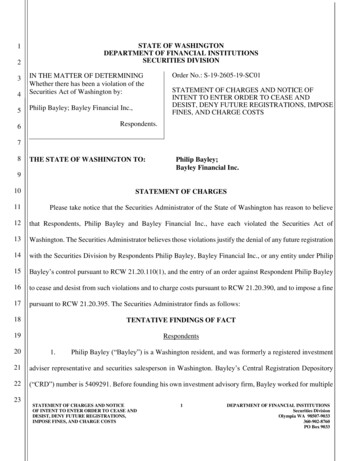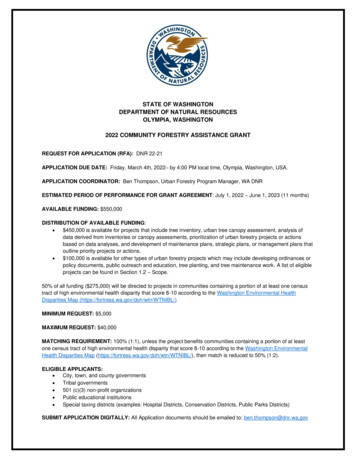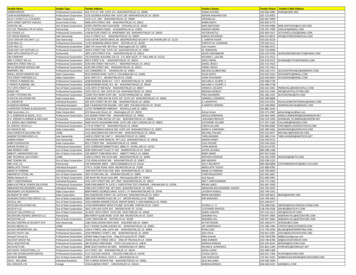
Transcription
STATE OF WASHINGTONDEPARTMENT OF FINANCIAL INSTITUTIONSSECURITIES DIVISION124IN THE MATTER OF DETERMININGWhether there has been a violation of theSecurities Act of Washington by:5Philip Bayley; Bayley Financial Inc.,3Order No.: S-19-2605-19-SC01STATEMENT OF CHARGES AND NOTICE OFINTENT TO ENTER ORDER TO CEASE ANDDESIST, DENY FUTURE REGISTRATIONS, IMPOSEFINES, AND CHARGE COSTSRespondents.678THE STATE OF WASHINGTON TO:Philip Bayley;Bayley Financial Inc.910STATEMENT OF CHARGES11Please take notice that the Securities Administrator of the State of Washington has reason to believe12that Respondents, Philip Bayley and Bayley Financial Inc., have each violated the Securities Act of13Washington. The Securities Administrator believes those violations justify the denial of any future registration14with the Securities Division by Respondents Philip Bayley, Bayley Financial Inc., or any entity under Philip15Bayley’s control pursuant to RCW 21.20.110(1), and the entry of an order against Respondent Philip Bayley16to cease and desist from such violations and to charge costs pursuant to RCW 21.20.390, and to impose a fine17pursuant to RCW 21.20.395. The Securities Administrator finds as follows:18TENTATIVE FINDINGS OF FACT19Respondents201.Philip Bayley (“Bayley”) is a Washington resident, and was formerly a registered investment21adviser representative and securities salesperson in Washington. Bayley’s Central Registration Depository22(“CRD”) number is 5409291. Before founding his own investment advisory firm, Bayley worked for multiple23STATEMENT OF CHARGES AND NOTICEOF INTENT TO ENTER ORDER TO CEASE ANDDESIST, DENY FUTURE REGISTRATIONS,IMPOSE FINES, AND CHARGE COSTS1DEPARTMENT OF FINANCIAL INSTITUTIONSSecurities DivisionOlympia WA 98507-9033360-902-8760PO Box 9033
1established firms in the financial industry, including NYLife Securities from October 2007 to April 2008,2Voya Financial Advisors Inc. from April 2008 to May 2009, and LPL Financial LLC from May 2009 to March32011.42.Bayley Financial Inc. (“BFI”) was a Washington corporation, originally incorporated on5January 16, 2014, with its principal places of business in Seattle, Washington and Union, Washington.1 Bayley6voluntarily dissolved BFI on January 31, 2019. BFI was a registered investment advisor in the State of7Washington until December 31, 2018, at which point its registration lapsed due to a failure to renew. BFI’s8Investment Adviser Registration Depository number is 156442. At all times relevant to this action, Bayley9was the sole owner, employee, and investment adviser representative of BFI.10Related Parties113.Tahoe Resources, Inc. (“Tahoe”) was a Canadian corporation. Tahoe owned and operated gold12and silver mines operations in several different countries, including Canada, Guatemala, and Peru. Tahoe was13a publicly traded stock under the ticker symbol TAHO until February 2019, when it was purchased by Pan14American Silver Corp., another mining company.154.TD Ameritrade, Inc. (CRD #7870) is a broker-dealer. Bayley and BFI (collectively “the16Respondents”) used TD Ameritrade as the asset custodian and trading platform for clients until late 2018,17when TD Ameritrade terminated their relationship due to the Respondents’ failure to meet margin calls in18client accounts.19Background Concepts2021221BFI was the successor firm to Bayley Financial LLC, which was originally formed on January 17, 2011 and subsequently becameinactive on February 6, 2014, after Bayley moved his business operations to BFI.23STATEMENT OF CHARGES AND NOTICEOF INTENT TO ENTER ORDER TO CEASE ANDDESIST, DENY FUTURE REGISTRATIONS,IMPOSE FINES, AND CHARGE COSTS2DEPARTMENT OF FINANCIAL INSTITUTIONSSecurities DivisionOlympia WA 98507-9033360-902-8760PO Box 9033
15.Suitability is a concept involving whether a given investment or mix of investments is2appropriate for a particular investor. In order to comply with suitability obligations, financial professionals3must generally (a) collect certain information about clients such as their financial status, tax status, and4investment objectives; and (b) have reasonable grounds to believe their investment recommendations are5suitable based on that information. For instance, a portfolio of risky stocks might be suitable for a young6investor who wants high returns and expects to have time to make up any losses, but that same portfolio might7be unsuitable for an investor approaching retirement who would not have time to make up losses, even if the8stocks would be expected to perform better on average than a more conservative portfolio. Failing to gather9suitability information will make it substantially more difficult for an advisor to manage a client’s portfolio10in a way that is consistent with their client’s goals.116.Diversification, in the financial industry, refers to investing in a variety of different assets12rather than concentrating them in one asset. Diversification can take several different forms, such as13diversification within a sector (investing in the stock of many different technology companies), diversification14across industries (investing in the stock of technology, retail, and mining companies), and diversification15across asset classes (investing in stocks, corporate bonds, and treasury bills). Financial-industry regulators,16such as the Securities and Exchange Commission and the Financial Industry Regulatory Authority, have17published information on diversification and its potential benefits, along with the risks of overconcentration18in a particular asset or asset class.219207.Margin trading is the practice of borrowing money from a financial firm (generally a broker-dealer) in order to fund additional transactions in an account. The use of margin can substantially magnify an21222See Securities and Exchange Commission, Beginners' Guide to Asset Allocation, Diversification, and Rebalancing (Aug. 28,2009), ons/investorpubsassetallocationhtm.html; Financial Industry RegulatoryAuthority, Concentrate on Concentration Risk, tration-risk.23STATEMENT OF CHARGES AND NOTICEOF INTENT TO ENTER ORDER TO CEASE ANDDESIST, DENY FUTURE REGISTRATIONS,IMPOSE FINES, AND CHARGE COSTS3DEPARTMENT OF FINANCIAL INSTITUTIONSSecurities DivisionOlympia WA 98507-9033360-902-8760PO Box 9033
1investor’s gains or their losses. If the value of the investor’s margin account falls below a certain level, the2lender may issue a “margin call,” which requires the investor to sell some of the assets in the account or3deposit additional funds to bring it back up to a minimum level. The lender for a margin account also generally4requires interest payments, often at very high rates, if an investor uses margin for long periods of time. Due5to the risk of substantial losses from margin trading, it is generally unsuitable for investors with low risk6tolerances and elderly or retired investors who are relying on their investment portfolio to fund their7retirement.89Summary8.From at least the beginning of 2016 until their termination from the TD Ameritrade platform,10Bayley and BFI violated the suitability requirements of the Securities Act in multiple ways. First, they failed11to collect or update key suitability information from clients. Second, in June 2016, they concentrated client12portfolios in a triple-leveraged inverse exchange-traded fund of mining stocks, which was unsuitably risky13for at least some clients and resulted, for instance, in a retired client losing 17% of her portfolio in one day.14Third, they concentrated their clients entirely in Tahoe stock from late 2016 until their termination from the15TD Ameritrade platform, exposing their clients to unnecessary risk that the Tahoe stock would not perform16well. Fourth, they recommended the use of margin trading to purchase additional Tahoe stock, and failed to17perform any analysis of whether the use of margin trading was appropriate for the clients. Fifth, they18recommended to many clients that they convert their standard IRAs to Roth IRAs so the clients would not19have to pay future taxes on promised gains in the Tahoe stock, which resulted in substantial tax bills for those20clients without the promised gains. Bayley also misrepresented or failed to disclose material information in21recommending that clients maintain or increase their positions in Tahoe stock.2223STATEMENT OF CHARGES AND NOTICEOF INTENT TO ENTER ORDER TO CEASE ANDDESIST, DENY FUTURE REGISTRATIONS,IMPOSE FINES, AND CHARGE COSTS4DEPARTMENT OF FINANCIAL INSTITUTIONSSecurities DivisionOlympia WA 98507-9033360-902-8760PO Box 9033
19.As a result of Bayley’s unsuitable investing decisions, his clients experienced massive2investing losses. Many of his clients lost well over half of their portfolios from late 2016 to late 2018, at a3time when the stock market as a whole was performing extremely well.Bayley’s Failure to Collect Suitability Information4510.During his initial meetings with clients, Bayley failed to collect key suitability information6from clients, such as their investment objectives, risk tolerance, and investment time horizon. Bayley also7failed to regularly consult with clients to determine whether their goals or risk tolerance had changed. Bayley8was or should have been aware of the need to collect and update suitability information because he had9previously worked for multiple financial firms which collected such information as part of their ordinary10practices, and because his firm’s own compliance manual and compliance checklist described the need to do11so.1211.Specifically, BFI’s compliance manual provided that “[d]uring BF, INC’s initial Client13meeting, we will gather information relative to the Client’s Risk Tolerance and have them complete a Client14Agreement . . . BF, INC will attempt to contact its Clients no less than annually to review current investments,15any changes in Clients financial or risk tolerance condition [all sic].” BFI’s compliance calendar also indicated16the need to “[c]onfirm clients’ investment objectives and restrictions” at the beginning of their relationship17with BFI, and “[u]pdate clients’ investment objectives and restrictions” at least once every three years. In18testimony before the Securities Division, Bayley indicated that he had purchased these materials from a19compliance consultant when establishing BFI, and did not establish any method for ensuring that the policies20and procedures in the manual were followed. Despite having a compliance manual which provided that he21was the Chief Compliance Officer and was “responsible for all compliance and supervisory functions,” and a22checklist which described his responsibilities, Bayley testified that he was under the impression that TD23STATEMENT OF CHARGES AND NOTICEOF INTENT TO ENTER ORDER TO CEASE ANDDESIST, DENY FUTURE REGISTRATIONS,IMPOSE FINES, AND CHARGE COSTS5DEPARTMENT OF FINANCIAL INSTITUTIONSSecurities DivisionOlympia WA 98507-9033360-902-8760PO Box 9033
1Ameritrade was responsible for BFI’s compliance responsibilities. Bayley also claimed, in a letter to the2Securities Division, that he had never heard of the Securities Act of Washington, the laws which govern his3conduct as an investment adviser, and did not recall having read the section of his compliance manual which4described the need to review applicable state laws as part of the investment process. Additionally, before5founding BFI in 2011, Bayley worked for several established financial firms for a combined total of6approximately three and a half years. As a result of working for these firms, Bayley was or should have been7aware of standard practices in the financial industry, such as collecting and updating suitability information8from clients.9Rather than tailoring his investment strategy to his individual clients’ needs (for instance, by12.10making safer investments for older clients), Bayley took an identical or near-identical approach for all of his11clients. From at least the beginning of 2016 until his termination from the TD Ameritrade platform, Bayley12generally bought the same asset for every client’s portfolio, and concentrated his clients’ portfolios almost13entirely in the same asset. Bayley generally attempted to find assets which he believed were undervalued14based on the fundamentals of the company, although he also sought to profit from market momentum on at15least one trade.Bayley’s Unsuitable Trades in DUST161713.On at least one occasion, Bayley’s failure to collect the required suitability information led to18him making unsuitably risky investments in the accounts of a retired client who, if Bayley had asked them,19would likely have indicated that they had a conservative or moderate risk tolerance. In particular, Bayley20made unsuitable investments in at least one client account in the Direxion Daily Gold Miners Index Bear 3x21exchange-traded fund (hereinafter “DUST,” its ticker symbol). DUST is a fund which tracks the performance22of a basket of mining company stocks, and is designed to return three times the inverse of the performance of23STATEMENT OF CHARGES AND NOTICEOF INTENT TO ENTER ORDER TO CEASE ANDDESIST, DENY FUTURE REGISTRATIONS,IMPOSE FINES, AND CHARGE COSTS6DEPARTMENT OF FINANCIAL INSTITUTIONSSecurities DivisionOlympia WA 98507-9033360-902-8760PO Box 9033
1that basket. For instance, if the mining stock basket gains 1% in a particular trading day, DUST will lose 3%2of its value, but it will gain 3% in value if the basket declines by 1%. Because it involves the use of high3leverage and risks substantial losses if the market performs well in a given day, DUST and similar investments4are often unsuitable for investors with conservative or moderate risk tolerances who cannot afford significant5losses—particularly when the entire portfolio is concentrated in such investments.614.Bayley’s trades in DUST were wholly unsuitable for at least some of his clients, who were7often retired or approaching retirement. For example, P.C. is a retired Washington resident and a former client8of BFI, whose entire retirement portfolio was managed by Bayley. P.C. stated in an interview with the9Division that her preference for Bayley’s investing strategy was to avoid losing money. In June 2016, Bayley10made two purchases of DUST in P.C.’s account, buying a combined total of 62,937 shares for 863,205.48.11These represented approximately 92.5% of the total value of P.C.’s account at the time. Bayley then sold all12of the shares the following day for 714,854.32, which represented a loss of approximately 17.2% on the13investment and 15.9% of the total value of the account in a single day. When asked about this transaction in14testimony, Bayley did not recall having incurred such massive losses in a client’s account.The Respondents’ Unsuitable Tahoe Activity151615.Throughout most of 2015, the Respondents purchased substantial amounts of Tahoe stock for17their clients’ accounts. They then sold it from November 2015 to January 2016, earning a reasonable profit18on the trade. After the Respondents sold the Tahoe stock, it continued to rise, and Bayley faced criticism from19some clients who thought that he had sold the stock too early. As a result, Bayley decided to buy Tahoe again20once it had dropped in price, with the expectation that it would rise again after that.212223STATEMENT OF CHARGES AND NOTICEOF INTENT TO ENTER ORDER TO CEASE ANDDESIST, DENY FUTURE REGISTRATIONS,IMPOSE FINES, AND CHARGE COSTS7DEPARTMENT OF FINANCIAL INSTITUTIONSSecurities DivisionOlympia WA 98507-9033360-902-8760PO Box 9033
116.On November 7, 2016, the Respondents began purchasing substantial amounts of Tahoe stock2for their clients’ portfolios. The closing price on that day was 10.91. Below is a chart of Tahoe’s daily closing3prices from the beginning of 2015 to the end of 2018.456Tahoe Stock Daily Closing Price, 2015-20181816Bayley beginsconcentrating his clientsalmost entirely in Tahoe14712810891011642012131417.As of the end of 2016, almost all of the Respondents’ client portfolios were almost entirely15concentrated in Tahoe stock. The concentration of client portfolios in the stock of one mining company was16unsuitable in multiple ways. First, concentrating a client entirely in one company’s stock unnecessarily17exposes them to various risks, such as the company underperforming, the stock price not significantly18climbing even if the company performs well, or the advisor incorrectly evaluating the company’s prospects.19Second, for clients who are retired or approaching retirement and cannot afford major losses, it is often20unsuitable to concentrate their portfolios entirely in stock because stock is generally considered the riskiest of21the major asset classes.2223STATEMENT OF CHARGES AND NOTICEOF INTENT TO ENTER ORDER TO CEASE ANDDESIST, DENY FUTURE REGISTRATIONS,IMPOSE FINES, AND CHARGE COSTS8DEPARTMENT OF FINANCIAL INSTITUTIONSSecurities DivisionOlympia WA 98507-9033360-902-8760PO Box 9033
118.During the summer of 2017, Tahoe was forced to close one of its mines, a silver mine in2Guatemala, due to legal issues with indigenous tribes in the area. Although the mine was not necessarily3permanently closed and could reopen depending on the outcome of court proceedings, Tahoe stock4substantially declined after the closure. This decline illustrates another major risks of overconcentrating a5portfolio in one stock: unexpected events at a company can rapidly reduce the value of the portfolio in ways6that a more diversified portfolio could easily withstand.719.When clients expressed concerns about declines in the value of Tahoe, or about having their8entire portfolio in one stock, Bayley repeatedly told them that the stock would go up and blamed various9causes for the stock’s underperformance. For instance, at various times in emails to clients, Bayley blamed10corruption in the Guatemalan government, short-sellers, and George Soros funding protests against the11Guatemalan mine. Bayley repeatedly told clients, particularly throughout 2018, that Tahoe was a 20 stock12and that the stock price was going to double, triple, or even quadruple. Bayley wrote the following to clients13at various points in 2017 and 2018:14a. “[Tahoe] is still a minimum 12-17 stock when the mine reopens (remember gold output15is increasing 40% later this year) and 20-22 stock if a little enthusiasm returns to the sector16by the end of the year”17b. “[Client should] buy more Tahoe for a short-term 50-70% pop . . . It’s a 20 stock you can1819buy for 4.40.”c. “In 2016 [Tahoe] went from 6 to 17 in less than 6 months so it can and will happen202122again.”d.“[Tahoe] should be going up 50 % next month when the court rules to reopen one of itsmines. Later this year I expect it to go up to 20 for a 400% gain (if not this year then23STATEMENT OF CHARGES AND NOTICEOF INTENT TO ENTER ORDER TO CEASE ANDDESIST, DENY FUTURE REGISTRATIONS,IMPOSE FINES, AND CHARGE COSTS9DEPARTMENT OF FINANCIAL INSTITUTIONSSecurities DivisionOlympia WA 98507-9033360-902-8760PO Box 9033
12019 for sure). If you have any extra funds this is the time to front-load your Roth IRA2funding for this year before the stock jumps. My friend recently borrowed from his 401k3so he and his wife could max fund his Roth for 2017 and 2018 ( 22k minus their previous4contributions). Then he will pay back his 401k plus interest that gets credited 100% to his5own 401k. When Tahoe goes up into the 20s, they will have a 70k gain plus their 22k6initial investment.”7e.“300-500% gains over the next couple of years would get you in the driver’s seat to retire8whenever you want. That’s why I’m staying course for you and my other clients. History9repeats and that’s the average expectation coming out of a bear market. It’s worth the wait10. . . history shows we will be heavily rewarded with substantial triple digit gains.”11f. “When [Tahoe]’s back to 10, you’ll have a 35% gain. I anticipate Tahoe going to 20 12later this year resulting in a 171% gain and liquidation value of 146,000 off an initial13investment around 54,000.”14g. “Since the stock is valued upon its cash flow, expect it to go up 100-150% by year end. If1516some interest returns to the sector, like in 2016, then expect 400% by year end.”h.“I got a message that you called in to liquidate your account. Please do not do that because17[Tahoe] stock is going up 50-100% very soon when a mine is allowed to reopen. The stock18price changes on how much cash it generates so when their big silver mine one reopens the19stock will jump up 50-60% immediately and that is expected to occur next week . . . The20court should rule next week and the company should immediately jump into the 8, or 60%21higher and then slowly go up to 20 sometime later this year or early next year. The2223STATEMENT OF CHARGES AND NOTICEOF INTENT TO ENTER ORDER TO CEASE ANDDESIST, DENY FUTURE REGISTRATIONS,IMPOSE FINES, AND CHARGE COSTS10DEPARTMENT OF FINANCIAL INSTITUTIONSSecurities DivisionOlympia WA 98507-9033360-902-8760PO Box 9033
1company plans to turn its dividend back on that is nearly 5% yield that you can take for2income.”320.In making these representations about the Tahoe stock price, in particular his high degree of4certainty that the stock would rise, Bayley failed to disclose a variety of material information which would5have been relevant to investors’ level of trust in his recommendation. In particular, Bayley failed to disclose6that his price target for Tahoe stock was more than double that of independent analysts, which to Bayley’s7recollection were approximately 9 per share as of early 2018. Bayley also failed to disclose that he had no8knowledge of the Guatemalan legal system and the laws involved in the proceeding. Bayley further failed to9disclose that he was planning to leave the investment adviser profession and felt a need to make a profit for10his clients before doing so, which had the potential to cause him to make unreasonably risky investments to11seek quick profits. Bayley also owned substantial amounts of Tahoe stock himself, but failed to disclose in12writing the material conflict of interest that resulted from his ownership, such as the possibility that selling13his clients’ positions could cause the value of his own stock to decrease. By representing that the stock price14was certain to increase, Bayley was able to convince most of his clients to continue investing in Tahoe, or15even to increase their investments, leading to further losses in their portfolio.Bayley’s Unsuitable Recommendation of Roth IRA Conversions161721.Bayley also convinced approximately eight clients to convert their IRAs to Roth IRAs, on the18grounds that the Tahoe stock would go up significantly and they would not have to pay taxes on the gains19thereafter. Converting an IRA to a Roth IRA is allowed by tax laws, but requires the investor to count the20converted amount in their income for the year and pay taxes on it. For example, an investor with 100,000 of21taxable salary income who converted a 200,000 IRA to a Roth IRA would have 300,000 in taxable income22for the year of the conversion.23STATEMENT OF CHARGES AND NOTICEOF INTENT TO ENTER ORDER TO CEASE ANDDESIST, DENY FUTURE REGISTRATIONS,IMPOSE FINES, AND CHARGE COSTS11DEPARTMENT OF FINANCIAL INSTITUTIONSSecurities DivisionOlympia WA 98507-9033360-902-8760PO Box 9033
122.In recommending the Roth conversion, Bayley failed to obtain sufficient information to2determine whether the conversion was appropriate for the customer, such as their tax status and available3liquid funds. In particular, Bayley failed to analyze whether the clients had sufficient liquid assets to pay their4tax bills if the stock did not go up. Bayley also based his recommendation partly on his belief that his clients5could change the Roth IRAs back to standard IRAs, but was unaware that the 2017 changes to the tax laws6prohibited this reconversion.3723.The Tahoe stock did not go up as Bayley had predicted, and many of the clients are currently8facing substantial tax bills for the 2018 tax year. For example, Bayley recommended the Roth conversion to9B.S., a 75-year-old client who had been retired since 2003. As a result, B.S.’s tax bill this year was10approximately 34,000. Due to the Roth conversion and Bayley’s mismanagement of her account, B.S. has11been forced to return to work to cover her expenses.12Bayley’s Unsuitable Use of Margin Trading1324.In January 2018, Bayley contacted his clients with non-IRA or Roth IRA accounts and14recommended that they buy even more Tahoe stock on margin. Based on these discussions, Bayley bought15Tahoe stock on margin in the account of three different clients throughout early 2018.1625.Bayley did not perform any suitability analysis for recommending the use of margin to17purchase Tahoe stock. In particular, Bayley failed to analyze the risks associated with margin trading, the18potential impact of interest payments on the borrowed margin funds, the potential consequences for his clients192032122Bayley claimed in testimony that his understanding was based on a phone conversation with a TD Ameritrade employee, but hedid not document that conversation in any way. The repeal of the Roth recharacterization had been publicized in multiple outletswell before Bayley made his recommendations. See, e.g., Dan Caplinger, The Roth IRA Trick Congress Is Planning to Take Away,The Motley Fool (Dec. 17, 2017, 4:17 PM), MENT OF CHARGES AND NOTICEOF INTENT TO ENTER ORDER TO CEASE ANDDESIST, DENY FUTURE REGISTRATIONS,IMPOSE FINES, AND CHARGE COSTS12DEPARTMENT OF FINANCIAL INSTITUTIONSSecurities DivisionOlympia WA 98507-9033360-902-8760PO Box 9033
1if the stock went down or stayed flat, and whether the use of margin was appropriate at all for his retired and2elderly clients.326.The use of margin trading was unsuitable for at least one of the Respondents’ clients. For4example, P.C. (the retired client discussed in the above section on DUST) was one of the clients Bayley5convinced to buy additional Tahoe stock on margin. Because P.C. was retired and could not afford significant6losses, the use of margin to concentrate her account even further in Tahoe stock—thereby exposing her to7even greater risk than Bayley’s other clients—was unsuitable.827.Additionally, Bayley’s long-term use of margin trading was unsuitable due to the substantial9required interest payments. For instance, at the beginning of January 2018, P.C. held 78,850 shares of Tahoe10stock, at 4.79 per share, for a total of 377,691.50. Bayley took out margin loans in January, March, and11April of 2018 to fund additional Tahoe purchases in P.C.’s account. The interest rate on the loan was initially127.75%, but rose to 8% for the later loans. By the end of April 2018, P.C. owned 162,700 shares of Tahoe stock13at 5.03 per share, but owed 445,187.13 to TD Ameritrade on the margin loan, for a total account value of14 373,193.87. Thus, even though the Tahoe stock had risen slightly during the year, P.C. had lost money in15her account, due largely to the margin interest payments. From January 2018 until the closure of her account16in October 2018, P.C. paid a total of 21,500—over 5% of the value of her account at the beginning of the17year—in margin interest payments alone, even before accounting for losses on the value of the Tahoe stock.18Bayley failed to perform any analysis of the potential impact of margin interest payments on his client19accounts if Tahoe stock did not rise immediately.2028.Tahoe’s stock price stayed largely flat in May and June 2018, but declined slightly near the21end of July. As a result of the stock price decline and the high concentration of Tahoe in the accounts, TD22Ameritrade issued repeated margin calls in July and August 2018 for all three of Bayley’s margin-using client23STATEMENT OF CHARGES AND NOTICEOF INTENT TO ENTER ORDER TO CEASE ANDDESIST, DENY FUTURE REGISTRATIONS,IMPOSE FINES, AND CHARGE COSTS13DEPARTMENT OF FINANCIAL INSTITUTIONSSecurities DivisionOlympia WA 98507-9033360-902-8760PO Box 9033
1accounts. Bayley failed to respond to the margin calls for several weeks, forcing TD Ameritrade to sell stock2in client accounts on multiple occasions. Bayley also failed to notify at least one client of the margin calls.329.As a result of these failures to meet margin calls, TD Ameritrade notified Bayley in August42018 that he would be terminated from the platform in October 2018, at which point his clients would be5converted to ordinary retail accounts. Bayley did not tell his clients that TD Ameritrade had terminated him6from the platform.730.In November 2018, Tahoe was purchased by another mining company, Pan American Silver8Corporation. Tahoe shareholders could elect to receive 3.40 per share in cash, or 0.2403 shares of Pan9American Silver Corporation per Tahoe share, plus additional shares contingent on the reopening of the10Guatemalan mine. With the contingent payment, the total value of the buyout was 4.10 per share,11approximately a 62% decline from the value of Tahoe stock at the time Bayley began concentrating his client12accounts in it.13Based upon the above Findings of Fact, the following Conclusions of Law are made:1415CONCLUSIONS OF LAW1.Prior to December 31, 2018, Bayley was a registered investment adviser representative in the16State of Washington, and was subject to the dishonest-and-unethical-practices regulations of WAC 460-24A-17220, the fraud prohibitions of RCW 21.20.020, and the suitability requirements of RCW 21.20.702.182.Prior to December 31, 2018, BFI was a registered investment adviser in the State of19Washington, and was subject to the dishonest-and-unethical-practices regulations of WAC 460-24A-220, the20fraud prohibitions of RCW 21.20
Diversification, in the financial industry, refers to investing in a variety of different assets rather than concentrating them in one asset. Diversification can take several different forms, such as diversification within a sector (investing in the stock of many different technology companies), diversification . Beginners' Guide to Asset .











